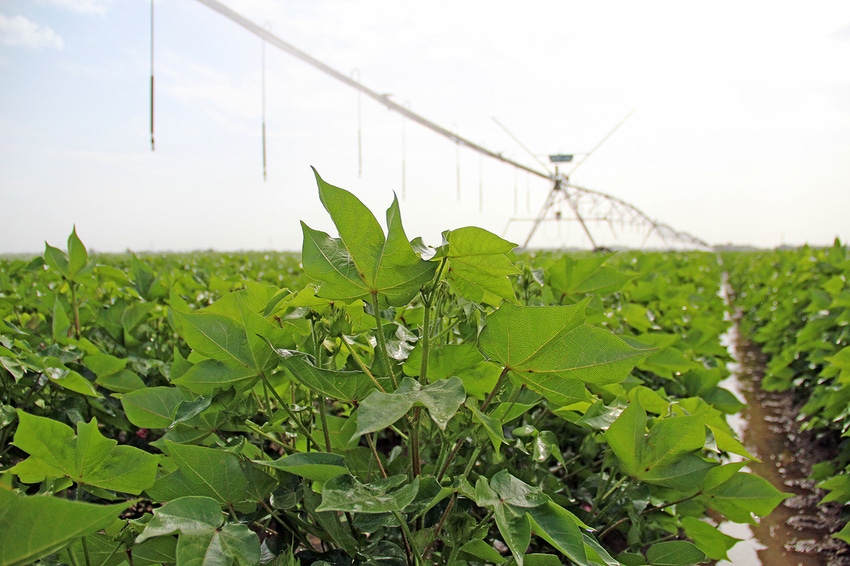
App for irrigating cotton among new features at 2016 Beltwide
“We like to use the term ‘more crop per drop,’” says Dr. Vellidis. “The App’s real strength is that it links environmental conditions and the crop’s growth stage to crop water use and thus can fairly accurately estimate how much water the plant is using and thus how much must be replaced.”
December 1, 2015

It’s taken years to get there, but farmers can now irrigate their crops with the flip of a switch – either on the control panel for a center pivot or to turn on the pump for a well connected to a roll of plastic irrigation pipe.
The trick is knowing when to flip that switch, according to irrigation specialists working with growers on the major row crops – cotton, corn, soybeans and grain sorghum – across the Rain Belt states in the Mid-South and Southeast.
Thankfully, cotton producers now have some help for making those decisions in an app developed by a scientists from the University of Georgia, University of Florida and Cotton Incorporated. The app, which is available for both iOS and Android platforms, is designed to provide growers with an easy-to-use, low-cost, science-based tool for scheduling irrigation.
“Research over many crops has shown that both the timing and the amount of irrigation is critical to optimizing water use efficiency and maintaining high yields,” says George Vellidis, the lead researcher on the team. He is scheduled to present a paper on the app at the Beltwide Cotton Conferences Consultant Conference in New Orleans Jan. 5.
The “Beltwide” will begin with the Consultants Conference at the New Orleans Marriott at 1 p.m. on Jan. 5 and continue with all 11 technical conferences through noon on Jan. 7. To register for the BCC, go to http://www.cotton.org/beltwide/index.cfm.
The Cotton SmartIrrigation App is one of several similar apps that the team from the University of Florida and the University of Georgia developed beginning in 2013. See www.smartirrigationapps.org for the full suite of apps.
Water balance model
The Cotton App is an interactive ET-based soil (ET=evapotranspiration) water balance model,” says Vellidis, an agricultural engineer who works in the Crop and Soil Sciences Department at the University of Georgia’s Tifton Campus.
“It uses meteorological data, soil parameters, crop phenology, crop coefficients and irrigation applications to estimate the amount of plant-available water in the root zone. It reports this information to the user in terms of soil water deficits. For example, a 15 percent deficit indicated that 15 percent of the plant available soil water in the root zone has been used.”
Vellidis says the deficit is also reported in terms of inches of water. For example, the 15 percent deficit may correspond to 0.25-inch of water.
“The model does not directly deliver irrigation application recommendations,” he notes. “However, the grower can use the information to make appropriate irrigation decisions. The App requires minimal inputs from the user (field location, generic soil type, and irrigation system type -- sprinkler or drip). No regular interaction is needed from the user.”
The App pushes notifications to the user at predetermined deficit thresholds, when rain occurs, and when the crop changes phenological stages (for example: first flower). “When the user irrigates, he or she must add the irrigation amount to the App. Rain data are assigned based on data from the closest weather station. If the user has field specific rain data, he can correct/update the App.”
Vellidis came to Tifton after receiving his Ph.D. in agricultural engineering with a minor area of emphasis in environmental engineering from the University of Florida in 1989.
“In my research program, I apply principles of engineering and the sciences to measure model, and manage the interaction between agricultural production systems and the environment,” he says. “Under this umbrella, I've developed two areas of emphasis – water resources and precision agriculture. Often these two areas blend.”
'More crop per drop'
The researchers believe the Cotton App can help farmers because it allows them to improve their water use efficiency.
“We like to use the term ‘more crop per drop,’” says Vellidis. “The App’s real strength is that it links environmental conditions and the crop’s growth stage to crop water use and thus can fairly accurately estimate how much water the plant is using and thus how much must be replaced.”
The App’s footprint is currently limited to Georgia and Florida because it pulls meteorological data from weather station networks in these two states, he notes. “By 2016 we will have a trial version that utilizes meteorological data from national data sets that NOAA provides.”
The Cotton App has been tested extensively on research farms at UGA and University of Florida. It was also been used by 233 users in 520 unique fields over the past two growing seasons in Georgia and Florida. It was released April 2014.
The App is free and available for both iOS and Android platforms. Users can find the link to download the App at www.smartirrigationapps.org. A tutorial is also available at this site.
“It can also be used to schedule variable rate irrigation (VRI). The user registers a new field for each irrigation management zone and the deficits for each field/zone can be used to create a VRI prescription map.”
The Cotton SmartIrrigation App is one of a number of new tools and technologies that will be discussed at the Beltwide Cotton Conferences. To see the final program for the Beltwide, go to http://www.cotton.org/beltwide/assets/website_documents/2016/2016-bw-final-program.pdf.
About the Author(s)
You May Also Like





